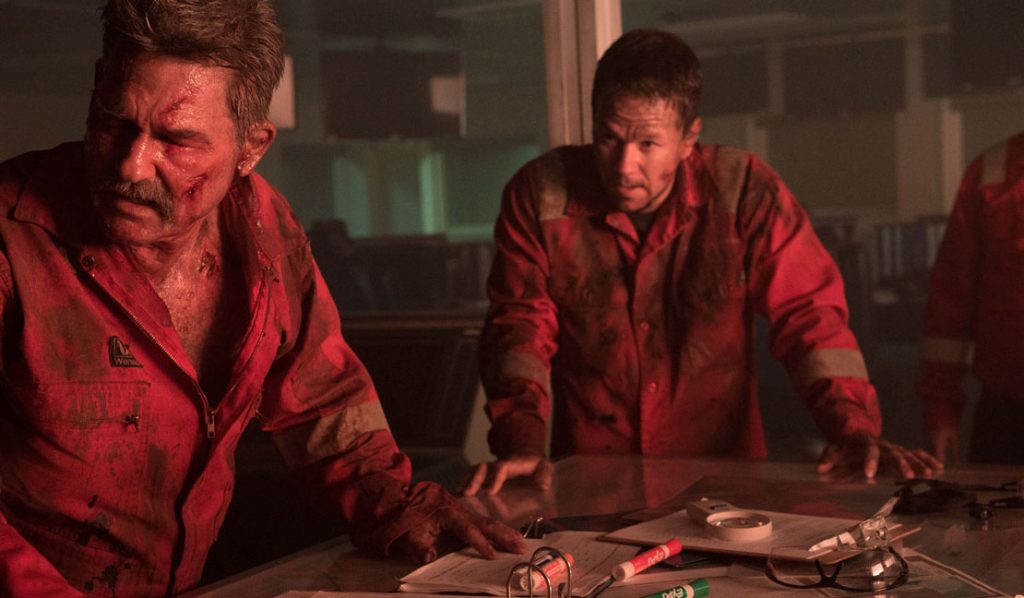Deepwater Horizon (2016)

Deepwater Horizon depicts the events leading up to and during what would eventually become the worst oil spill in the history of the United States, where the titular drilling rig, the largest in the world at the time, would explode under massive amounts of pressure in the Gulf of Mexico, killing eleven of the 126 people on board, just 52 miles off of the coast of Venice, Louisiana, on April 20, 2010. A burst of methane gas trapped over three miles below the ocean surface blast up the well, eventually blowing out on the rig, where oil would continue to rush into the Gulf for nearly three months straight.
In addition to the actual cataclysmic event, Deepwater Horizon shows many of the ways in which the accident could have and should have been prevented. The story showcases how corners had been cut in terms of safety precautions to step up the process that had been running 43 days behind schedule. There’s a good deal of expository information to cover so that laymen in the audiences will understand the basics of deep sea oil exploration and fundamental physics when it comes to how pressure can affect the process along the way. Experts in the area will feel that the film is a rudimentary approach to a highly technical process, but the filmmakers do succeed in making the elaborate procedures understandable enough to follow along while they happen.
Mark Wahlberg (Daddy’s Home, Ted 2) stars as Mike Williams, the chief electronics technician working for Transocean, who leaves his adoring wife (Hudson, Kung Fu Panda 3) and young daughter behing for a three-week stint on the rig that is currently under lease by giant petroleum corporation, British Petroleum (BP). Despite the fact that BP suits are on site to present the crew chief, Jimmy Harrell (Russell, The Hateful Eight), with a safety award, the rig is encountering many niggling issues that are preventing them from staying on schedule. The BP agents downplay these issues, wanting the rig workers to get to what they really need to do: extract petroleum and make the company lots of money in the process, but Jimmy is the man in charge, and won’t proceed unless it’s safe for his men to do so. Red flags are there, but the corporate interests prevail, ultimately resulting in full steam ahead, and, of course, tragedy strikes, resulting in massive explosions, a rain of fire, and crushing equipment threatening the lives of everyone on board the rig.
It takes approximately half of the movie before the terrifying events begin happening, allowing director Peter Berg (Lone Survivor, Battleship) and the screenwriters Matthew Sand (Ninja Assassin) and Matthew Michael Carnahan (World War Z, State of Play) a chance to build up a few of the main characters, as well as to set the table for the impending tragedy that we all know is sure to follow, especially in the ways we see how the disaster might have been prevented had profit not been the primary consideration from the higher-ups overseeing the project (BP will no doubt not be happy with the portrayal of their company on any level, especially in John Malkovich’s (Zoolander 2) particularly slimy turn as real-life BP executive Donald Vidrine, shown, probably fictitiously, as a careless corporate stooge as weasely as the one portrayed by Paul Reiser in Aliens). The editing is tight, the sound design a key component to deliver atmosphere in a dark and dangerous vessel, feeling very much like a straightforward disaster movie, though without some of the soapier elements that tend to make many that take the same approach sag. With plenty of American flags captured on the visible frame, which is a bit misguided given that it isn’t a patriotic movie from a national service standpoint, there’s a callback to the kinds of blue-collar disaster flicks of the 1990s from the likes of Michael Bay and Roland Emmerich.
Interesting is Berg’s decision to make this a personal film for the people affected by the disaster, eschewing an epilogue in which we see how the disaster affected a great many people in the Gulf, as well as much of the fallout that took place in the media and in government hearings regarding the matter, save for a couple of clips of the real-life survivors, and a few words written on the screen to let us know that virtually no one took blame for the disaster from a legal standpoint. While it does play like an an action-thriller a good part of the time, Berg keeps the tone respectful, always putting the human loss in the tragedy first and foremost in our minds as we witness the disparaging results of profit-first corporate decision-making run amok.
While it likely plays broader than the actual situation, and takes great liberties on the part of the story to deliver movie foreshadowing and actos of action-adventure heroism, as a piece of so-called entertainment surrounding a real-life tragedy, Berg manages to deliver something that’s engaging enough to watch as a film to satify audiences looking for pure escapist entertainment, while still maintaining enough homage to the people that were the most deeply affected by the tragedy, especially those who would not make it out of the blowout alive. There are a lot of moving parts at play, but unlike the real-life Deepwater Horizon, its cinematic namesake delivers what’s intended without much of a hitch.
Qwipster’s rating: A-
MPAA Rated: PG-13 for prolonged intense disaster sequences and related disturbing images
Running Time: 107 min.
Cast: Mark Wahlberg, Kurt Russell, Kate Hudson, John Malkovich, Gina Rodriguez, Ethan Suplee, Dylan O’Brien
Cameo: Peter Berg, Trace Adkins
Director: Peter Berg
Screenplay: Matthew Michael Carnahan, Matthew Sand (based on the New York Times article, “Deepwater Horizon’s Final Hours”, by David Rohde and Stephanie Saul)
